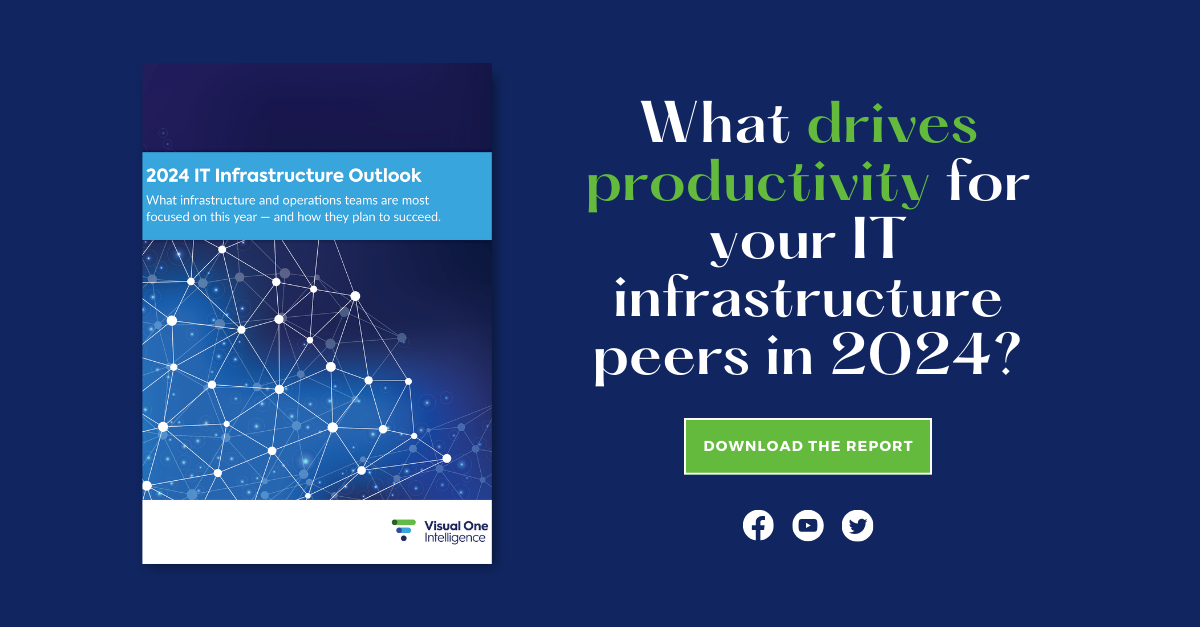Share this:
You know Visual One Intelligence can help reduce storage costs. But how exactly? And what does that look like if you’re simultaneously moving to the cloud?
Does this sound familiar? You’ve got a lot of on-prem storage. You’ve been steadily migrating some to the cloud (or maybe you’re just about to start), but budgets are tight. The pressure is on to accelerate your cloud migration while somehow also keeping costs down – no CapEx hardware purchases.
What’s an infrastructure team to do?
It’s no surprise that this is a common reality for organizations today. In one recent survey of over 250 infrastructure operations professionals, two of their top three priorities for 2024 were “migrating from on-prem to cloud infrastructure” and “reducing cloud costs.”
If this is you, Visual One Intelligence can help you:
- Find ways to get more out of your existing storage space,
- Ensure your storage devices don’t run out of space,
- Reduce your on-prem dependency by accelerating cloud migrations.
This is Part 1 in our series “How Can I…” in which we look at common scenarios facing hybrid infrastructure teams and outline the ways Visual One Intelligence can help. (Read Part 2 here.)
Maximize Storage Efficiency, Accelerate Cloud Migrations
As an example, let’s look at Helping Hands Hospital (not a real organization; their story combines the experiences of multiple Visual One clients). As a healthcare organization with 8 PB of on-prem storage distributed across multi-vendor assets (including NetApp and Pure Storage), Helping Hands is in the early stages of migrating some of their on-prem storage to the cloud.
By choosing Visual One Intelligence, they hoped that centralized observability across their on-prem and cloud environments would cut costs by making their storage more efficient and expediting their migration efforts.
Less is More: Making Storage More Cost-Efficient
With a data environment as big as Helping Hands’, sprawl is inevitable. But even they were surprised to find out how much sprawl had occurred – and how much could be repurposed for new data.
Using Visual One, their infrastructure team immediately found and repurposed 700 TB of orphaned storage. Additionally, they discovered 400 TB of available space on their NetApp storage that was hidden inside “volume-locked” arrays – a consequence of NetApp’s unique architecture.
Thanks to healthcare regulations regarding data retention, Gotham General had also accumulated massive archives of patient data. It had been easier to simply keep buying more low-tier storage for additional archives than to find and delete the data they were no longer required to keep.
Now, using Visual One’s file analysis tool, they were able to identify 400 TB of data ready to be deleted or re-tiered to cheaper storage. And they did it all in a single afternoon, without needing to spend days manually reviewing the data.
With plenty of data not yet migrated to the cloud, their on-prem storage remains critical. But with Visual One, they found and repurposed 1.5 PB of data – potentially saving $500,000 through recovered space and asset cost avoidance.
Plan Ahead: Capacity Planning Ensures There’s Always Enough Space
Although discovering this “hidden” available space helped, Helping Hands still needed to ensure they would not unexpectedly run out of space and need a last-minute storage purchase (or risk a costly outage).
With Visual One’s capacity planning and forecasting, they discovered three devices at risk of running out of space within the next year. They also discovered two more devices that appeared to have enough space but would actually have maxed out due to a planned project that wasn’t accounted for in their previous capacity planning models.
Most significantly, Helping Hands narrowly avoided a crisis. Because their Pure Storage devices utilize data-reduction, their available capacity sometimes fluctuated unpredictably based on data-reduction changes. When the data reduction on one Pure device changed suddenly one week, it went from having 40% available space to 12% – putting it on track to run over-capacity in less than 30 days.
Thanks to an alert from Visual One, however, Helping Hands was able to re-allocate data from the device and fix what was causing the data-reduction change, avoiding a $100,000 emergency storage purchase.
Altogether, Visual One’s capacity planning helped the infrastructure team avoid at least three emergency purchases and at two outages – resulting in over $200,000 of cost avoidance.
Pick Up the Pace: Accelerating Cloud Migration
In order to move on-prem data to the cloud, a lot has to be planned in advance. That includes deciding which data to put on which cloud resource – with minimal operational disruptions and maximum cost savings.
Since Visual One combines storage, cloud, and compute data within one analytics tool, Helping Hands able to do these kinds of analyses and make accurate decisions faster.
For example, Visual One’s migration modeler helped them optimize workloads before migrating. Then, using Visual One’s cost comparison tool, they compared the costs of their current workloads with the equivalent costs on AWS – helping confirm that migrating a given workload would save money (otherwise, it should stay where it is).
By right-sizing early, avoiding waste, and reducing analysis time, Helping Hands saved $50,000.
Lower Costs & Better Utilization
After a year of using Visual One Intelligence, Helping Hands’ IT director and infrastructure team were commended for keeping costs down and launching their multi-year cloud migration efforts.
Altogether, relying on Visual One helped their team obtain over $750,000 in savings by creating efficiencies and avoiding costs – a 500% ROI when considering Visual One’s low cost.
With Visual One, all of our on-prem and hybrid infrastructure clients feel confident in their ability to keep costs minimized and evolve their architecture – including by cutting cloud costs post-migration.
There’s a lot to consider when evaluating software tools. That’s why we offer demos on-demand: no waiting, no sales pitch.
Not yet ready to explore? All good! Follow us on LinkedIn or subscribe to our infrastructure newsletter to keep tabs on Visual One and hybrid infrastructure news.






